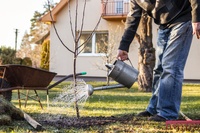
This month, as part of Veganuary, many of us are trying to adopt a more vegetarian or vegan lifestyle. To help, we’ve put together a few tips on being more vegan in the way we garden.
What is Veganuary?
Veganuary is the world's largest vegan movement, inspiring people to try vegan for January and throughout the rest of the year. Try a vegetarian or vegan lifestyle this month and help mother earth. Eating vegetarian or vegan isn't too difficult. Read our tips to start this year healthy. Can you hold on to your New Year's resolutions?
Tips for vegan gardening
Vegan gardening is about growing plants without the use of animal products and chemicals. It involves learning to live with garden pests like slugs and insects rather than reaching for the pesticide bottle and making choices that are good for the environment as a whole and our gardens. Becoming a vegan gardener doesn’t happen overnight, but here are a few ways to start.
-
Let a part of your garden go a bit wild, and you’ll reap the benefits of the wildlife that will soon arrive. Long grass provides a habitat for insects, shady, damp log piles encourage frogs, and hedges bring in birds and even hedgehogs, which all do their bit to keep pests like slugs and aphids under control.
-
Grow some of your own food. Having a vegetable patch helps, but it’s surprising how many plants can be grown in small spaces. Beans, peas, tomatoes and even dwarf fruit trees can be grown in pots, and salad leaves will thrive on a sunny windowsill, as will many herbs. The best thing about growing your own food is that you really know exactly what’s gone into it.
-
Make your own compost. Get a compost bin or use pallets to build your own, and add your garden cuttings and vegetable scraps – obviously no dairy or meat products, though. Add some torn-up cardboard to aerate your compost and give it the right balance of carbon and nitrogen.
-
Learn to live with garden pests. Plant young seedlings out later so they’re less attractive to slugs and protect them with copper tape. Invest in nets or barriers to protect plants from cabbage white butterflies, carrot flies and hungry birds. And consider planting more than you need, so you can afford to lose a few plants.
-
Don’t use animal manure for fertilizer. Instead, feed your soil by sowing green manure crops like clover and digging the plants back into the soil to break down. Practice crop rotation to avoid depleting soils, and mulch with your own compost, if you have enough.
-
To make your own high-potassium liquid plant food, fill a bucket with chopped up comfrey leaves, top it up with water, put a lid on and leave it for 2-4 weeks (best to put it far away from the house - it smells!) Strain out the leaves, dilute the black liquid from 1 part comfrey tea to 10 parts water, and feed tomatoes and other fruiting plants.
Whether you’re new to gardening or an old hand, you’ll find everything you need in our centres, so visit us and get your gardening year off to a great start.




